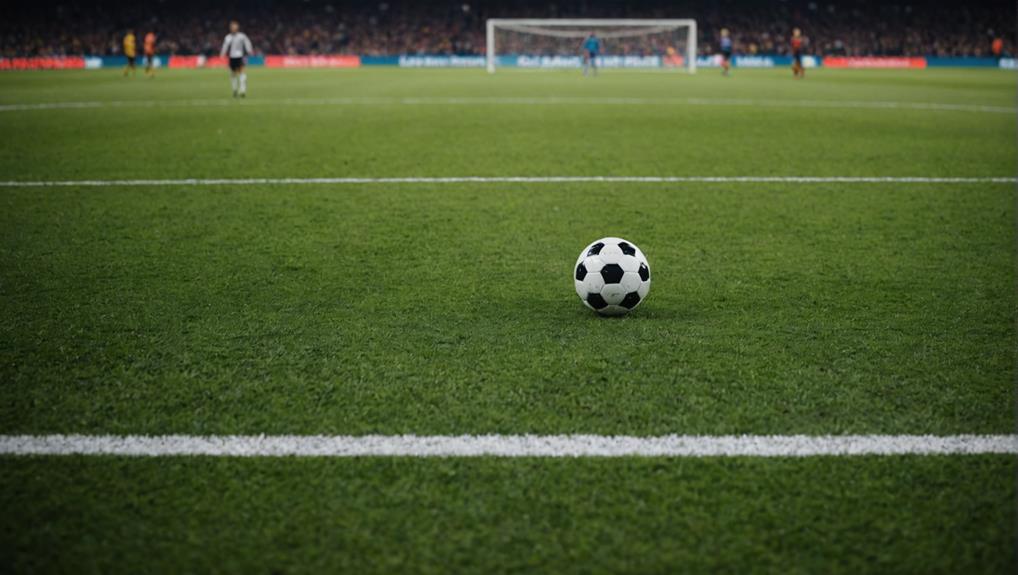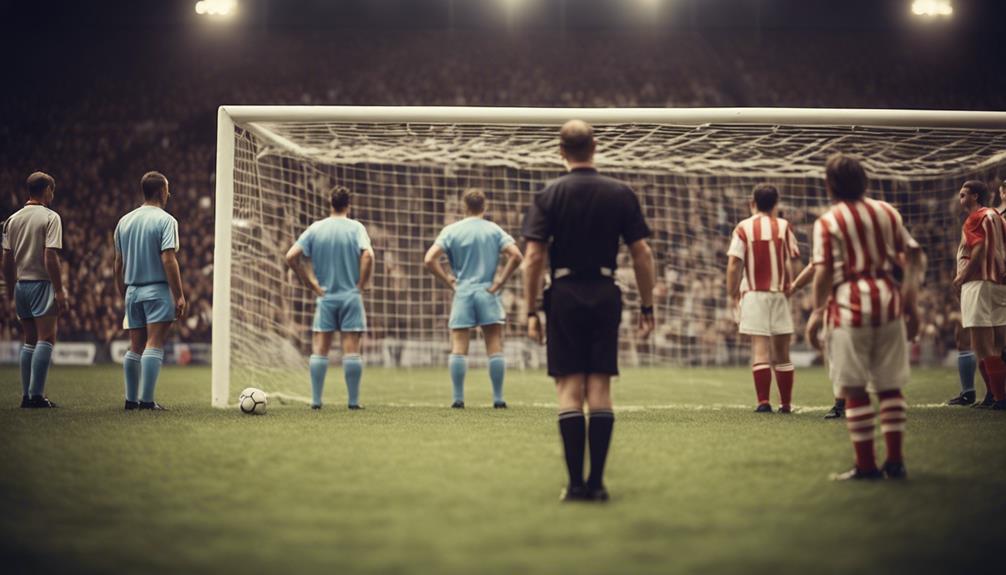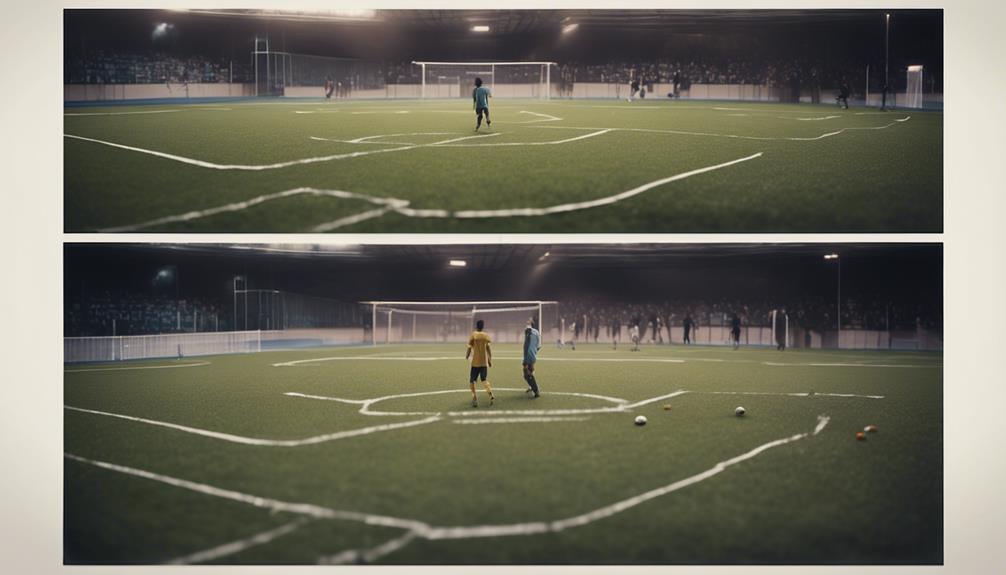
Understanding Key Soccer Regulations
July 25, 2024Unravel the essential rules of soccer. Fields measure 100 to 130 yards long, with specific markings like penalty areas. Starting with a center circle kick-off, it's important to be 10 yards away. Set pieces involve corner kicks and defense distance during free kicks. Don't forget the offside rule! Penalties for fouls result in free or penalty kicks, with yellow and red cards for serious offenses. Understand various fouls to play fairly. Playoffs feature single elimination matches and tiebreakers, ensuring fair matchups. Master these basics to enhance your soccer knowledge.
Soccer Field Dimensions
Explore the standard dimensions of a soccer field to gain a better understanding of the game's playing area. A regulation soccer field typically ranges from 100 to 130 yards in length and 50 to 100 yards in width.
Field markings, such as boundary lines, touchlines, end lines, and goal lines, delineate the boundaries of the pitch. The penalty area, also known as the 18-yard box, is an important area where fouls can lead to penalty kicks.
The center circle is significant for kickoffs at the start of each half and must be respected by the opposing team. Additionally, corner kicks are awarded when the ball crosses the goal line without resulting in a goal.
Understanding these key elements of the soccer field dimensions is essential for comprehending the game's dynamics and strategic play. Take note of these markings and areas to navigate the field effectively during matches.
Kick-Off Procedure
To begin a soccer match, the kick-off procedure initiates the game from the center circle with one team starting the play by kicking the ball to their opponent. The opponent must be at least 10 yards away to guarantee a fair start.
The team that wins the coin toss can choose to kick off or pick which goal to attack. During the kick-off, the ball must move forward for the play to be considered valid.
A goal can't be scored directly from a kick-off; the ball must touch another player before finding the back of the net. This rule prevents teams from simply booting the ball straight into the opponent's goal right from the start.
Set Piece Rules

During set pieces in soccer, players must adhere to specific rules and positioning. Corner kicks are awarded when the ball crosses the goal line after the last touch by a defender. The attacking team places the ball inside the corner arc for the kick.
Free kicks are given for fouls, and the defending team must maintain the required distance from the ball. Players often strategize to score directly from a free kick or create scoring opportunities.
Goal kicks are taken by the defending team when the ball goes out of play over the goal line without a goal being scored. The ball is placed anywhere inside the six-yard box for the goal kick.
Penalty kicks are awarded for fouls committed inside the penalty area, giving the attacking team a direct shot at goal from the penalty spot. Proper positioning and following set piece rules are essential for both defending and attacking teams to maximize scoring opportunities and prevent conceding goals.
Offside Rule Explanation
Let's break down the offside rule into three key points:
Offside Basics Simplified
Offside Position Explained
Offside Decision Factors
Understanding these points will help you grasp the concept and application of the rule during soccer matches. By knowing these aspects, you can better comprehend how offside situations are determined and why certain decisions are made on the field.
Offside Basics Simplified
Understanding the offside rule in soccer is essential for players, coaches, and fans alike. Offside occurs when an attacking player is closer to the opponent's goal line than both the ball and the second-last defender when the ball is played to them. This rule aims to maintain fairness by preventing goal-hanging and balancing the game between attackers and defenders.
Offside is only called if the player in the offside position becomes actively involved in play, such as receiving the ball or interfering with an opponent. Timing is vital; the player must be in an offside position when their teammate plays the ball to them. Offside violations lead to an indirect free kick for the defending team from the spot where the offside player was when the ball was passed.
Understanding these basic offside principles is fundamental to appreciating the flow and fairness of the game.
Offside Position Explained
To grasp the concept of the offside rule in soccer, it's important to understand the definition of being in an offside position. A player is in an offside position if they're closer to the opponent's goal line than both the ball and the second-to-last opponent.
Simply being in an offside position isn't considered an offense; it only becomes an offense when the player in that position is involved in active play by receiving the ball from a teammate.
When an offside offense occurs, the opposing team is awarded an indirect free kick from the spot where the offside player was when the ball was played.
The offside rule's primary purpose is to prevent players from gaining an unfair advantage by positioning themselves too close to the opponent's goal, thereby maintaining fairness and ensuring strategic gameplay.
Understanding and abiding by the offside rule is essential for promoting fair competition on the soccer field.
Offside Decision Factors
When determining offside in soccer, important factors include timing, positioning, and the player's involvement in the play. Timing is essential as the player's position concerning the opponent's goal line and the second-last defender is assessed the moment the ball is played by a teammate.
Being closer to the opponent's goal line than both the ball and the second-last defender puts a player in an offside position, potentially gaining an unfair advantage.
Proper positioning on the field is significant to avoid being caught offside. Players must be mindful of their placement relative to the defenders to stay onside and actively participate in the game without infringing on the offside rule.
The player's involvement in the play, whether they're impacting the game from an offside position, also plays a significant role in the offside decision.
Penalties and Consequences

Penalties in soccer can result in various disciplinary actions like free kicks, penalty kicks, yellow cards, or red cards depending on the severity of the foul.
Yellow cards serve as warnings, indicating that the player is being cautioned. On the other hand, red cards signify that the player must leave the game, often resulting in their team playing with one less player.
Referees play an important role in enforcing penalties to guarantee fair play and adherence to soccer regulations. It's vital for players to respect the decisions made by referees regarding penalties, as disobedience can lead to further consequences.
Understanding the implications of fouls and penalties is essential for all involved in soccer, including players, coaches, and fans. By being aware of the potential outcomes of committing fouls, individuals can uphold the integrity of the game and promote sportsmanship on and off the field.
Player Fouls and Punishments
You need to understand the different types of fouls in soccer and the consequences they carry.
Knowing the specific penalties associated with each foul is essential for players on the field.
Let's break down the foul types and clarify the resulting penalties for a better grasp of soccer regulations.
Foul Types Explained
Understanding the various types of player fouls and the corresponding punishments is vital for all involved in soccer to comprehend the game's regulations and maintain fair play.
Player fouls in soccer can range from minor infringements like tripping to more serious offenses such as dangerous tackles. Referees have the authority to award free kicks or penalty kicks depending on the severity of the foul committed.
Unsportsmanlike conduct, such as dissent or simulation, may result in the display of yellow or red cards to players. A yellow card serves as a warning, while a red card leads to a player's ejection from the game, leaving their team with a numerical disadvantage.
It's important to note that referees have the discretion to determine the appropriate punishment for different player fouls based on the Laws of the Game. Understanding these distinctions will help players, coaches, and fans grasp the consequences of various infractions and uphold the principles of fair competition in soccer.
Penalty Consequences Clarified
Exploring the repercussions of player fouls in soccer provides insight into the disciplinary measures enforced to maintain fair play on the field. When a player commits a foul, the consequences can vary depending on the severity of the offense. Minor infractions may result in the opposing team receiving a free kick from the spot of the foul.
More serious fouls, especially those committed inside the penalty area, can lead to penalty kicks, giving the offended team a direct scoring opportunity. In cases of unsportsmanlike conduct, referees may issue yellow cards as a warning. These cautionary measures are meant to deter further misconduct.
However, persistent or severe infractions can result in a red card, leading to the player's immediate expulsion from the game. Referees play a vital role in enforcing these penalties to uphold fair play and maintain the integrity of the sport.
Understanding the disciplinary actions associated with fouls is essential for all involved in soccer, promoting a respectful and competitive environment on the field.
Outdoor Vs. Futsal Regulations

When comparing outdoor soccer regulations to futsal regulations, it's essential to note the distinct differences in playing conditions and rules governing each sport.
In outdoor soccer, matches are played on a larger field with 11 players per team, allowing for more physicality and endurance.
On the other hand, futsal is played indoors on a smaller court with only 5 players per team, emphasizing ball control, quick passes, and skillful play due to the restricted playing area.
Outdoor soccer features 11 players per team on a larger field.
Futsal is played with 5 players per team on a smaller court.
Ball control and skillful play are emphasized in futsal due to the smaller playing area.
Outdoor soccer allows for more physicality and endurance.
Both sports follow similar rules for scoring goals and using a round ball but exhibit distinct gameplay and regulations.
Playoff Formats and Tiebreakers
Comparing outdoor soccer regulations to futsal rules, the playoff formats and tiebreakers in soccer tournaments play a significant role in determining advancing teams and resolving deadlocks.
In soccer playoffs, teams often face single elimination matches where the winner progresses to the next round, while the loser exits the competition. Tiebreakers come into play when teams are tied, and various factors like goal difference, head-to-head results, or even a penalty shootout can determine the victor.
Leagues sometimes divide teams into Flight A and Flight B playoff brackets to promote fair competition among teams of similar skill levels. Playoff seeding is important as it dictates the matchups based on teams' performance in the regular season.
In the event of a tie during playoffs, sudden death or extra time periods may be implemented to determine a clear winner, adding an extra layer of excitement and tension to the matches.
Conclusion
Now that you understand the key soccer regulations, you're ready to hit the field and show off your skills.
Remember, the game is a beautiful balance between strategy and athleticism, where every rule and decision can make or break a match.
So lace up your cleats, grab your ball, and go out there with confidence.
Embrace the challenge and enjoy the thrill of the game.
Good luck!


